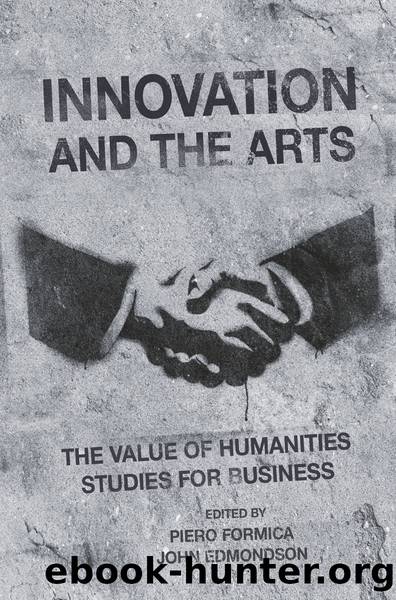Innovation and the Arts by Formica Piero;Edmondson John;

Author:Formica, Piero;Edmondson, John;
Language: eng
Format: epub
Publisher: Emerald Publishing Limited
Published: 2019-12-10T00:00:00+00:00
Acknowledgement
The author is a member of two programme areas for research at the University of Stavanger ââPhilosophy and subjectivityâ (IN-11746) and âThe Greenhouse: An Environmental Humanities Initiative at University of Stavangerâ (IN-11621).
References
Alvaredo, F., Chancel, L., Piketty, T., Saez, E., & Zucman, G. (2017). World inequality report 2018. Paris, France: World Inequality Lab.
Aristotle (2009). The Nicomachean ethics (D. Ross, Trans.). Oxford: Oxford University Press.
Bergthaller, H., & Mortensen, P. (Eds.). (2018). Framing the environmental humanities. Leiden, The Netherlands: BrillâRodopi.
Bolt, J., Inklaar, R., de Jong, H., & van Zanden, J. L. (2018). Maddison Project Database, version 2018. Rebasing âMaddisonâ: New income comparisons and the shape of long-run economic development. Maddison Project Working Paper 10. Retrieved from www.ggdc.net/maddison
Brentari, C. (2015). Jakob von Uexküll: The discovery of the Umwelt between biosemiotics and theoretical biology. Dordrecht, The Netherlands: Springer.
Champagne, M. (2011). Axiomatizing Umwelt normativity. Sign Systems Studies, 39(1), pp. 9â59.
Costello, K., & Hodson, G. (2010). Exploring the roots of dehumanization: The role of animalâhuman similarity in promoting immigrant humanization. Group Processes and Intergroup Relations, 13(1), pp. 3â22.
Daly, H. (2013). Foreword. In B. Czech (Ed.), Supply shock: Economic growth at the crossroads and the steady state solution (pp. ixâxi). Gabriola Island, Canada: New Society Publishers.
Deely, J. (2009). Basics of semiotics (5th ed.). Tartu, Estonia: Tartu University Press.
Donaldson, S., & Kymlicka, W. (2011). Zoopolis: A political theory of animal rights. Oxford: Oxford University Press.
Farina, A. (2012). A biosemiotic perspective of the resource criterion: Toward a general theory of resources. Biosemiotics, 5(1), pp. 17â32.
Favareau, D., Kull, K., Ostdiek, G., Maran, T., Westling, L., Cobley, P. ⦠Wheeler, W. (2017). How can the study of the humanities inform the study of biosemiotics? Biosemiotics, 10(1), pp. 9â31.
Grooten, M., & Almond, R. E. A. (Eds.). (2018). Living planet report â 2018: Aiming higher. Gland, Switzerland: WWF.
Hausman, D. M. (2018). Philosophy of economics. In E. N. Zalta (Ed.), The Stanford encyclopedia of philosophy (Fall 2018 ed.). Retrieved from https://plato.stanford.edu/archives/fall2018/entries/economics/
Hoffmeyer, J. (1996). Signs of meaning in the universe. Bloomington, IN: Indiana University Press.
IPBES. (2019). Summary for policymakers of the global assessment report on biodiversity and ecosystem services of the Intergovernmental Science-Policy Platform on Biodiversity and Ecosystem Services. Retrieved from https://www.ipbes.net/system/tdf/spm_global_unedited_advance.pdf?file=1&type=node&id=35245
IPCC. (2018). Global warming of 1.5°C. Geneva, Switzerland: Intergovernmental Panel on Climate Change.
Kant, I. (1997). Of duties to animals and spirits. In P. Heath & J. B. Schneewind (Eds.), Lectures on ethics (pp. 212â213). New York, NY: Cambridge University Press.
Keynes, J. M. (1930). Economic possibilities for our grandchildren. In J. M. Keynes (Ed.). Essays in persuasion (pp. 358â373). New York, NY: W.W. Norton & Co.
Kymlicka, W. (2018). Human rights without human supremacism. Canadian Journal of Philosophy, 48(6), pp. 763â792.
Leakey, R., & Lewin, R. (1996). The sixth extinction: Patterns of life and the future of humankind. New York, NY: Anchor Books.
Linnell, J. D. C., Nilsen, E. B., Lande, U. S., Herfindal, I., Odden, J., Skogen, K., ⦠Breitenmoser, U. (2005). Zoning as a means of mitigating conflicts with large carnivores: Principles and reality. In R. Woodroffe, S. Thirgood, & A. Rabinowitz (Eds.), People and wildlife: Conflict or co-existence (pp.
Download
This site does not store any files on its server. We only index and link to content provided by other sites. Please contact the content providers to delete copyright contents if any and email us, we'll remove relevant links or contents immediately.
Innovation and the Arts by Formica Piero;Edmondson John;(295)
Killer Thinking by Tim Duggan(220)
The Year in Tech, 2025 by Harvard Business Review(213)
Containing Big Tech: How to Protect Our Civil Rights, Economy, and Democracy by Tom Kemp(167)
Innovation Power: How Technology Will Reshape Geopolitics by Eric Schmidt & Lant Pritchett & Dan Wang(149)
Transforming Entrepreneurship Education: Interdisciplinary Insights on Innovative Methods and Formats by Jantje Halberstadt Antonieta Alcorta de Bronstein Jean Greyling Shaun Bissett(143)
Harness the Juice by Aaron Alfini(114)
Artificial Intelligence for Business Analytics: Algorithms, Platforms and Application Scenarios by Felix Weber(111)
Jumpstart Your Customer Service by Shawn Doyle(104)
The Complete Idiot's Guide to a Successful Family Business by Neil Raphel(99)
The Power of Positive Destruction by Merrin Seth;Adler Carlye; & Carlye Adler(97)
Introducing the SAP Digital Boardroom by Unknown(96)
Predictive Data Mining Models by David L. Olson & Desheng Wu(95)
Handbook of Artificial Intelligence and Big Data Applications in Investments by Larry Cao CFA(94)
Being an Entrepreneur by Craig A. Barnett(92)
Interactive Journalism by Nikki Usher(91)
Super Affiliate YOU by Ben Fletcher(91)
Big Data Bootcamp by David Feinleib(84)
Information and Competitive Price Systems by Information & Competitive Price Systems(84)
